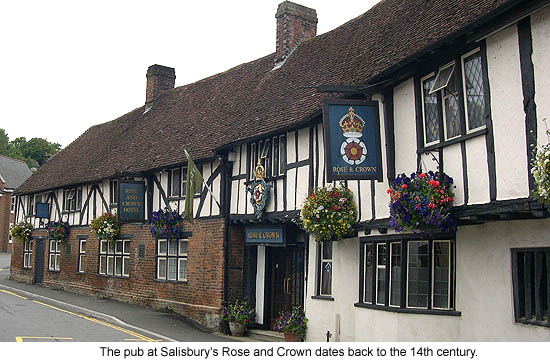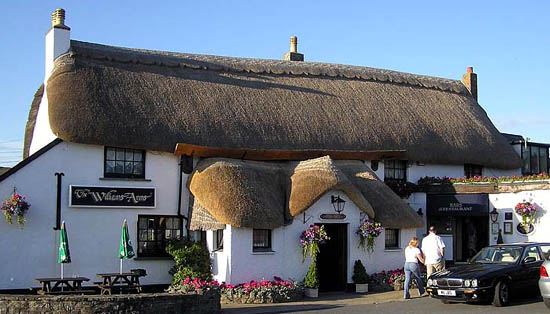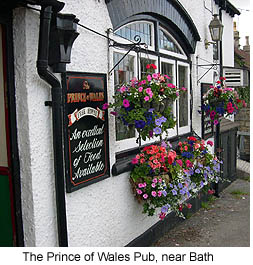A Beginner's Guide to British Pubs
by Graham Hughes
 The pub, short for 'public house', is an integral part of British life. In many parts of the world, most bars are little more than functional drinking holes. In Britain, though, a pub is typically much more than this: it can be a meeting place, an entertainment centre, the focal point of a community. As a visitor, popping into one or two pubs will help you to understand what the country and its people are like, beyond the usual tourist images of castles, royals and Shakespeare. The British Beer and Pub Association (BBPA) estimates that 80 per cent of adults consider themselves 'pub goers', and over 15 million -- nearly a third of the adult population -- drink in a pub at least once a week.
The pub, short for 'public house', is an integral part of British life. In many parts of the world, most bars are little more than functional drinking holes. In Britain, though, a pub is typically much more than this: it can be a meeting place, an entertainment centre, the focal point of a community. As a visitor, popping into one or two pubs will help you to understand what the country and its people are like, beyond the usual tourist images of castles, royals and Shakespeare. The British Beer and Pub Association (BBPA) estimates that 80 per cent of adults consider themselves 'pub goers', and over 15 million -- nearly a third of the adult population -- drink in a pub at least once a week.
Whether you want to sample the atmosphere, meet the locals, try the beer or just quench a thirst, here are some facts and tips to help you get the best out of a trip to a British boozer.
Where to go
If you're thinking of looking for a typical British pub, think again. There is no such thing. They come in all shapes, sizes and styles: from the traditional country pub, with real ales and an open fire (usually accompanied by an old man and his dog), to the bustling city-centre hotspot, with hordes of teens and twentysomethings shouting to each other over ear-splitting music.

The centres of the larger cities have the widest variety of pubs within easy reach of each other, and of the main visitor attractions. Some of them are old -- very old. Ye Olde Trip To Jerusalem, in Nottingham, is believed to be the oldest in England, dating back to 1189. Times are changing, though: many pubs are being taken over by large chain corporations (sadly losing some of their character in the process), and recent years have seen the rise of theme pubs and modern European-style bars.
In the suburbs, and in the smaller towns and villages, most pubs are best described as locals. The atmosphere in these places can vary -- some are very friendly, others can seem a little unwelcoming and even intimidating to outsiders. If you walk into a pub and get a bad feeling about it, don't hesitate to walk straight out again and look for somewhere more enticing -- the chances are that you will find it.
Who runs the show?

Most pubs are tied houses, owned and operated by breweries. A tied house must sell the beer provided by the brewery that owns it, but can usually sell an additional guest beer. It might be managed by a local landlord (who is really a tenant) on a lease basis, or by a manager on the brewery's payroll. Chain pubs are owned by companies which don't actually brew their own beer, although some of them are former breweries. A free house is fully independent, and can sell any brand of beer.
Can we eat here?
Until quite recently, few pubs offered anything more substantial than peanuts, crisps ('chips' in the US), and the ultimate pub snack: pork scratchings. Many small pubs still don't, but the overall trend is towards providing more, and better, food. The BBPA claims that British pubs now serve over a billion meals per year.
Some just offer sandwiches, while others have simple pub grub -- meat pies, sausages with mashed potatoes, and so on. Many larger pubs have specific areas reserved for eating, and offer more variety and quality. At the top end of the scale is the recent phenomenon of the gastropub, where the food is more sophisticated and cosmopolitan (and expensive).
Licensing laws
The minimum drinking age is 18. Children of 14 or over are allowed into pubs, but cannot drink alcohol (except for over-16s having meals in designated eating areas, accompanied by adults). A child under 14, if accompanied by an adult, is allowed into the bar area if the pub has a 'children's certificate' -- these pubs usually make it clear that children are welcome.
Not long ago, the smell of cigarette smoke was an inescapable part of pub life. Since the start of July 2007, though, smoking has been banned in all public buildings, including pubs, in England. Similar laws had already been passed in Scotland and Wales.
What to drink
 Now we're talking. But first... Golden Rule #1: Unless you enjoy being openly laughed at, never, under any circumstances, go into a British pub and ask for 'a beer'. The beer comes in several types, mostly very different to each other. Ask for a specific type, or use a brand name. Now we're talking. But first... Golden Rule #1: Unless you enjoy being openly laughed at, never, under any circumstances, go into a British pub and ask for 'a beer'. The beer comes in several types, mostly very different to each other. Ask for a specific type, or use a brand name.
For a taste of beer that is very popular and distinctively British, try a pint of bitter. Named after its bitter taste, this brownish-red ale is strongly flavoured with hops, has a wide range of strengths, flavours and aromas, thanks to the variety of brewing techniques used in different regions. Some pubs offer a long list of bitters, usually including guest beers which they only keep for a few days. Bitter is the main reason why we Brits are often ridiculed for drinking 'warm beer'. It isn't warm -- it just isn't ice-cold, and we wouldn't want it to be.
If you want something more familiar (and cold), pubs invariably offer lager (pronounced LAH-gur) -- the type of clear, light, sparkling beer found in most countries. Lager was almost non-existent in Britain until the 1960s, except in Scotland, but it now accounts for around half of the beer sold.
Other types include mild, quite similar to bitter, but generally darker and weaker; and stout, the thick, black beer usually associated with Ireland (Guinness is on tap in nearly every pub; British stouts are not so commonly found on draught). There is also cider, made from fermented apple juice (and not to be confused with the unfermented American drink of the same name), and dangerously popular in south-western England.
Scotland has its own categories of ale: a bitter-like beer known as heavy (with two sub-categories: 70 shilling and 80 shilling), and light (or 60 shilling), comparable to English and Welsh mild. The higher the number, the stronger the beer.
Draught beer is served in pints or half pints. Bottled beer, including foreign brands, is easily available. When ordering beer, ask for 'a pint of...', 'a half of...' or 'a bottle of...'.
Alcopops, spirits and limited ranges of wines are widely served in pubs. Low-alcohol beers are usually on offer, but a popular alternative is shandy, a 50-50 mix of draught beer and lemonade (ask for a bitter shandy or a lager shandy). Soft drinks are always available, such as fruit juices, mineral water, coffee, tea and the usual well-known sodas.

Can I get some service here?!
If you're sitting at a table: No. Golden Rule #2: Do not sit at a table and wait for someone to take your order. It won't happen. Brits with a sadistic sense of humour have been known to sit, giggling quietly, while nearby tourists have sat at a barren table waiting patiently (or otherwise) for a waiter or waitress to appear. To get some service, even if you're ordering food, go to the bar.
Bar etiquette is important. While waiting to be served, stay patient, and try not to shout out your order before someone who has been waiting longer. Whatever you do, don't wave your money around -- Brits really don't like this kind of thing. Just try to maintain eye contact, to make sure they know you're there. Be polite and respectful: bar staff in Britain don't appreciate being treated like servants.
The bar staff will not keep a tab for you -- drinks must be paid for as soon as they have been served. Tipping is not expected. In fact, it's almost unheard of. But if you're buying a large round, or staying in the same pub for quite a while, you could buy the barman or barmaid a drink while you're ordering (the code for this is '...and one for yourself') -- this isn't mandatory by any means, but it isn't unusual either.
Some of this may seem a little strange if you're unfamiliar with it -- but don't let it put you off. If you haven't been to a British pub, you haven't really been to Britain. So why not try one or two? And by the way, mine's a bitter.
Related Articles:
- The Historic Pubs of London, by Pearl Harris
- https://www.timetravel-britain.com/articles/london/pubs.shtml
- A History of Britain in Its Pub Signs, by Elaine Saunders
- https://www.timetravel-britain.com/articles/history/pubsigns1.shtml
- Haunted Pubs of England, by Dr. Gareth Evans
- https://www.timetravel-britain.com/articles/history/hauntedpubs.shtml
More Information:
We regret that we no longer have the resources to maintain up-to-date links and/or hours and pricing details for the various sites and attractions listed on this website. For more information about the location(s) listed above, please use your favorite search engine or visit Wikipedia.
Graham Hughes is a British-born computer analyst/programmer and freelance writer who has lived in both the UK and the US, with interests including sport, music, travel and current affairs. He is an author for Buzzle.com and eSports Media Group, and has contributed to Sports Fan Magazine.
Article © 2005 Graham Hughes
Photos: Rose & Crown, Prince of Wales, and New Inn © Moira Allen
Additional photos courtesy of Wikipedia.org
|
